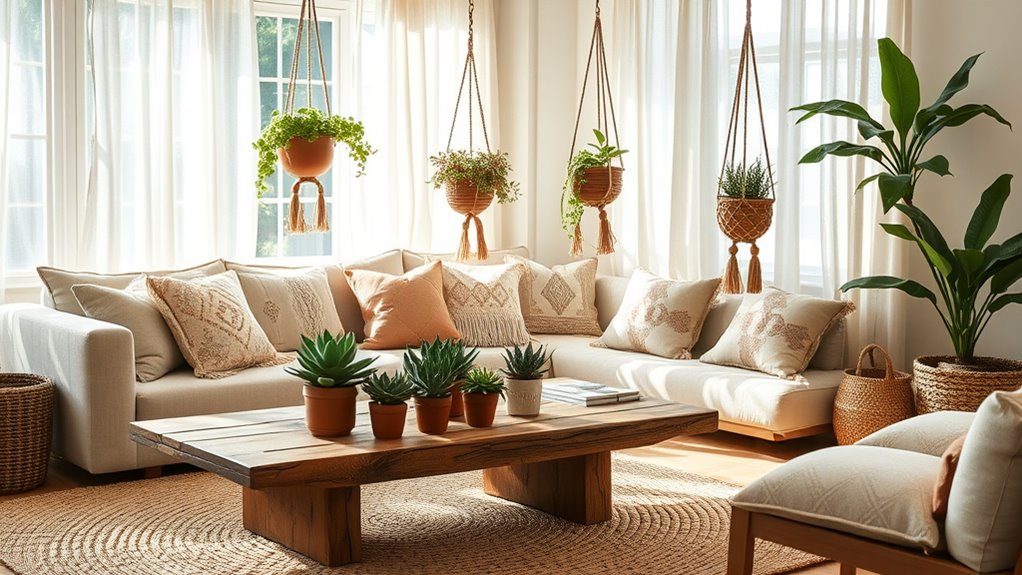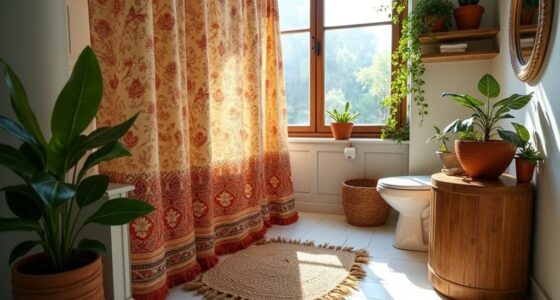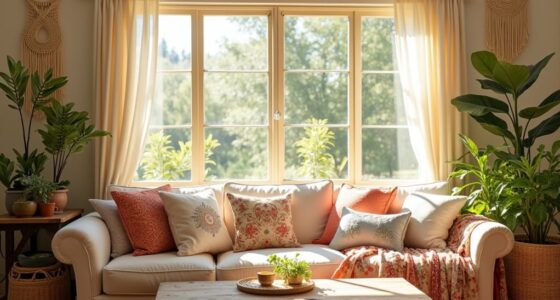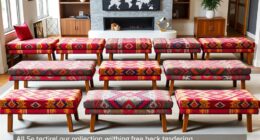To create eco-friendly boho decor, use natural materials like rattan, seagrass, jute, and sustainably sourced wood. Choose brands like The Citizenry, West Elm, and Woven that prioritize fair trade and responsible sourcing, supported by certifications like GOTS and FSC. Incorporate textures with natural fibers and eco-friendly finishes, mixing vintage and reclaimed pieces for character. By prioritizing sustainable shopping practices, you can craft a warm, culturally rich space that reflects your values—exploring further will reveal even more eco-conscious ideas.
Key Takeaways
- Incorporate natural, biodegradable materials like rattan, jute, and reclaimed wood to enhance eco-friendly boho interiors.
- Support brands with fair trade certifications (GOTS, B Corp, FSC) that prioritize responsible sourcing and artisanal craftsmanship.
- Use eco-conscious finishes such as plant-based dyes and water-based varnishes for sustainable textures and surfaces.
- Blend vintage, reclaimed, and upcycled decor pieces to add character while promoting sustainability.
- Choose packaging and shipping options that are biodegradable, recycled, or carbon-neutral to reduce environmental impact.
Embracing Natural Materials in Boho Spaces
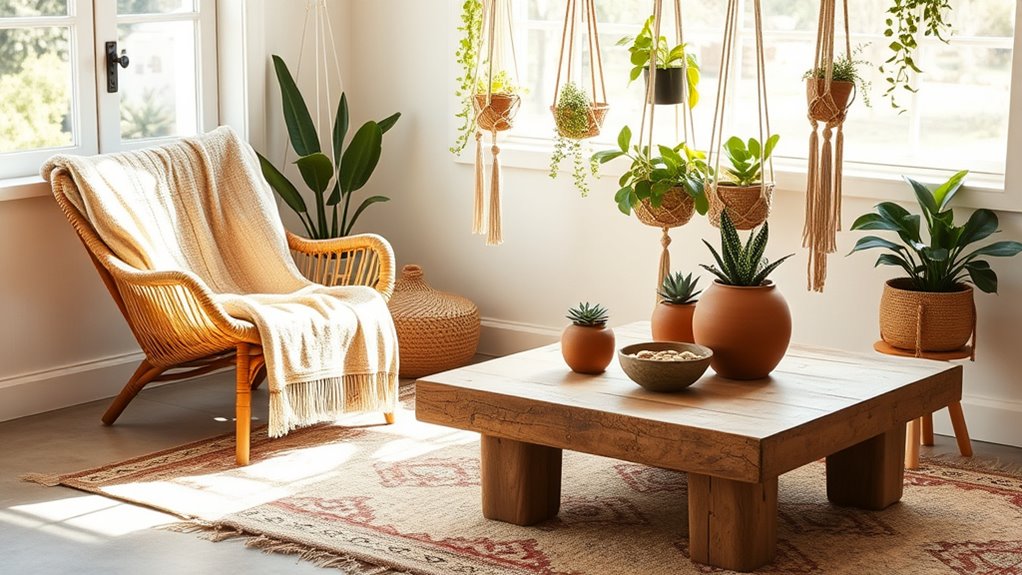
Embracing natural materials is essential for creating authentic and eco-friendly boho spaces. When you choose natural materials like rattan, wicker, jute, and seagrass, you bring durability and timeless appeal to your decor. These materials are perfect for boho decor because they add texture and organic warmth. Incorporating sustainably sourced wood, bamboo, and clay further enhances the organic aesthetic while supporting responsible harvesting practices. Handcrafted decor items made from natural fibers reduce environmental impact and promote artisanal craftsmanship globally. Using natural textiles such as linen, cotton, and organic dyes creates textured, layered spaces that emphasize comfort and eco-consciousness. Opting for biodegradable and renewable materials helps you elevate your design while minimizing waste, making your home a true reflection of sustainable living. Additionally, selecting self-watering plant pots made from eco-friendly materials can help maintain healthy plants while reducing water waste. Incorporating biodegradable materials in your decor choices not only supports sustainability but also contributes to a healthier environment for future generations. Choosing natural fibers and sustainable textiles ensures your decor remains both stylish and environmentally responsible, and exploring options like reclaimed wood can further reduce environmental impact.
Top Ethical Brands for Sustainable Home Decor
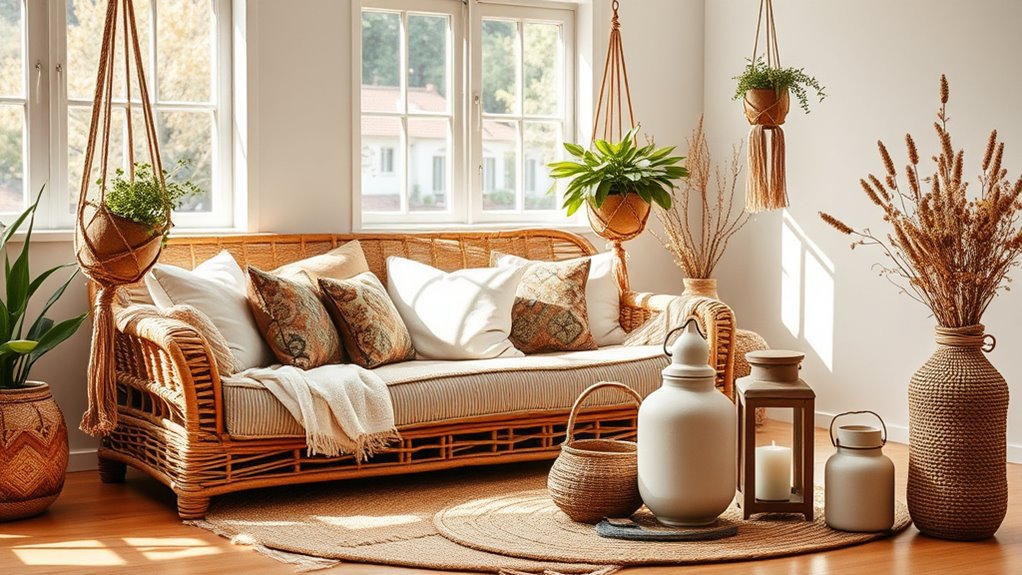
When selecting home decor that aligns with your eco-friendly values, choosing brands committed to ethical practices makes a meaningful difference. Ethical brands like The Citizenry, West Elm, and Woven prioritize fair trade practices, transparent sourcing, and the use of responsibly sourced materials in their collections. Many of these brands, including Lorena Canals and Etsy sellers, hold certifications such as GOTS, OEKO-TEX®, FSC, and B Corp, ensuring products are sustainably and ethically made. Supporting these brands helps promote longevity, durability, and reduced environmental impact. Additionally, understanding the importance of emotional support can help consumers feel more connected to their choices and encourage brands that prioritize social responsibility. Incorporating sustainable materials into home decor not only benefits the environment but also aligns with a holistic approach to wellness and ethical living. Practicing mindful consumption can further enhance your commitment to sustainability by encouraging thoughtful purchases that reflect your values. Recognizing the environmental impact of your choices empowers you to make more conscientious decisions in your home decor. Being aware of the certifications that verify ethical practices can also guide your purchasing decisions and ensure you support truly responsible brands.
How to Incorporate Eco-Friendly Textures and Finishes

To create an eco-friendly boho look, start by incorporating natural fiber textures like rattan, seagrass, and jute into your furniture and accessories. Choose handcrafted pieces with eco-friendly dyes and finishes, such as plant-based stains or water-based varnishes, to boost sustainability. Opt for matte or natural-looking finishes on wood and metal surfaces to keep your decor earthy and healthy.
Natural Fiber Textures
Incorporating natural fiber textures like rattan, seagrass, and jute instantly adds tactile warmth and eco-friendly appeal to your boho decor. Use these sustainable fibers in furniture, baskets, and rugs to create a cozy, earthy vibe. Woven wall hangings, placemats, and coasters crafted from organic materials build layered textures that enhance your space’s boho charm. Opt for handmade, artisanal finishes on furniture and accessories, emphasizing organic, untreated surfaces that develop a unique patina over time. Stick to neutral or earthy tones like beige, terracotta, and olive green to keep your decor authentic and grounded. Combining multiple natural textures, such as wicker, linen, and hemp, adds visual interest and depth, all while supporting environmentally responsible sourcing for a truly sustainable boho look. Additionally, paying attention to Vetted electric bike conversion kits ensures eco-friendly transportation options that align with sustainable living principles. Using eco-conscious materials in your decor choices further amplifies your commitment to sustainability and creates a cohesive, environmentally friendly aesthetic. Incorporating renewable energy sources like bike generators can also contribute to a more sustainable lifestyle, complementing your eco-friendly decor.
Eco-Friendly Finishes Use
Eco-friendly finishes enhance your boho decor by adding textured, sustainable accents that are safe for both your space and the environment. You can achieve this by using natural dyes and plant-based stains that deliver rich color without harmful chemicals. Incorporate non-toxic sealants and water-based varnishes to protect surfaces while maintaining a healthy indoor air quality. Opt for finishes created through eco-conscious processes that minimize waste and avoid harmful substances. Textured options like lime plaster or clay not only add tactile appeal but also align with sustainable principles. When finishing reclaimed wood or recycled metals, choose environmentally responsible methods to ensure your decor remains eco-friendly throughout its lifecycle. These finishes help create a beautiful, safe, and sustainable boho space you can enjoy guilt-free. Additionally, selecting eco-friendly finishes can contribute to the overall sustainability of water parks, promoting environmentally responsible recreation.
Sustainable Material Pairings
By thoughtfully pairing natural materials like rattan, seagrass, and bamboo, you can create textured layers that enhance the authenticity and sustainability of your boho decor. Combining these sustainable materials adds tactile richness while supporting an eco-friendly home. You can also mix recycled glass with organic textiles such as linen and cotton to promote sustainable finishes and visual interest. Incorporate eco-dyed fabrics alongside untreated wood or natural stone accents to emphasize environmentally conscious craftsmanship. Using woven baskets, seagrass rugs, and reclaimed wood furniture together creates a harmonious, textured aesthetic rooted in supporting ethical practices. To achieve a balanced, eco-friendly boho look, consider:
- Rattan, seagrass, and bamboo for textures
- Recycled glass and organic textiles
- Eco-dyed fabrics with untreated wood
- Woven baskets and reclaimed furniture
The Benefits of Choosing Fair Trade and Artisan-Made Pieces
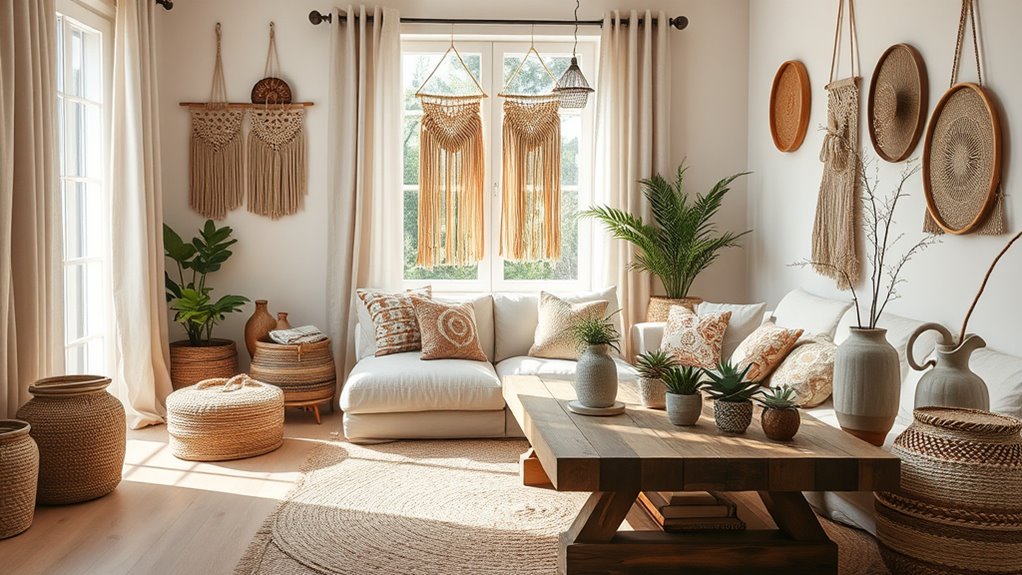
Choosing fair trade and artisan-made decor benefits both the environment and the people behind the craftsmanship. When you select fair trade items, you assure artisans receive fair wages and work in safe, ethical conditions, promoting social equity. Supporting artisan-made pieces helps preserve traditional craftsmanship and cultural heritage, keeping local art forms alive. Fair trade certification guarantees that materials are sustainably sourced, and production processes minimize environmental impact. Artisan-made decor often uses natural, biodegradable materials, reducing reliance on synthetic, harmful substances. By choosing these pieces, you empower communities economically and promote equitable global trade practices. Additionally, sustainable sourcing ensures that the materials used are environmentally responsible throughout their lifecycle. Incorporating environmentally friendly materials further reduces ecological footprints and supports conservation efforts. Promoting ethical brands further encourages responsible manufacturing practices and transparency in supply chains. Your conscious choices contribute to a more sustainable, ethical decor landscape, aligning your home’s style with your values and supporting a better future for artisans and the planet. Engaging with artisan communities also fosters the preservation of unique cultural traditions and skills. Moreover, understanding the certification processes behind these products can help consumers make more informed and ethical purchasing decisions.
Curating a Warm and Inviting Boho Atmosphere Sustainably
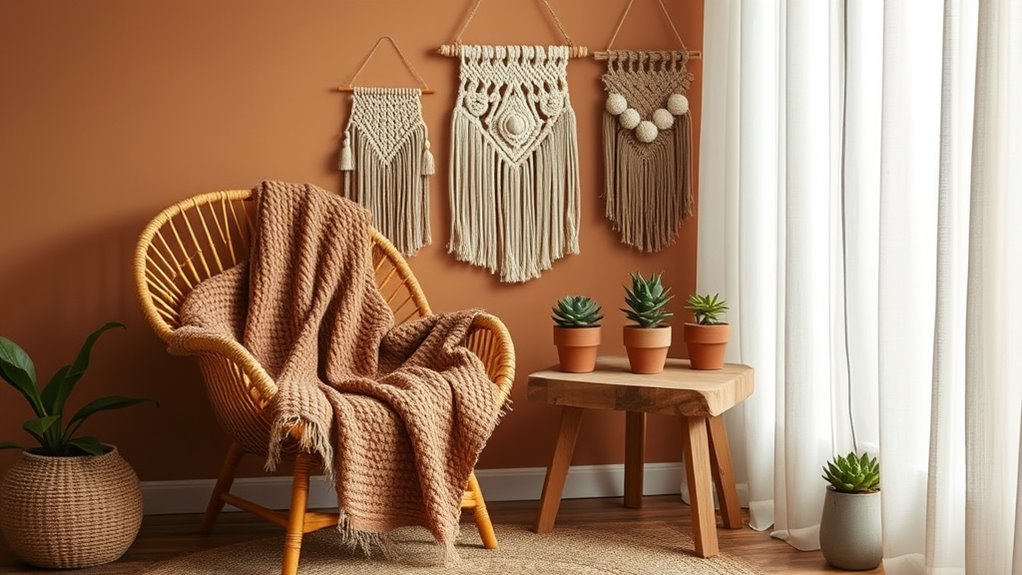
Creating a warm and inviting boho atmosphere sustainably starts with selecting natural materials like rattan, seagrass, and bamboo for furniture and decor. These organic materials bring earthy textures that reflect eco-friendly decor principles. To enhance your ethically made home, incorporate textiles such as organic linen, jute, and recycled fibers in cushions and wall hangings, adding comfort and visual interest. Supporting sustainable brands ensures your decor aligns with ethical craftsmanship. You can also showcase handmade, fair trade accents like woven baskets, pottery, and artisanal textiles to emphasize authenticity. Additionally, choosing discount codes for eco-friendly hosting services can help you save while maintaining a sustainable lifestyle. Finally, add indoor plants in natural planters to create a lively, organic vibe. Remember, choosing eco-conscious packaging and sustainably sourced decor pieces keeps your space eco-friendly and inviting.
Tips for Mixing Vintage and Reclaimed Decor Elements

You can create a balanced and stylish boho space by mixing vintage pieces with reclaimed decor thoughtfully. Highlight unique items like antique furniture or handcrafted textiles to add character, while keeping a cohesive color palette for harmony. Remember to blend new eco-friendly elements with your vintage finds to achieve an authentic, sustainable look. Incorporating a growth mindset can also inspire you to experiment with different textures and styles, ultimately enhancing your space’s creative potential. Embracing emotional alignment in your design choices can help you cultivate a serene and harmonious environment that reflects your personal values. Additionally, understanding how attention impacts your creative process can help you stay focused and intentional in selecting decor pieces that resonate with your aesthetic. Exploring retail hours such as those at Joanns or Costco can assist in planning your shopping trips for eco-friendly materials and vintage finds.
Balance New and Old
Blending vintage and reclaimed decor elements effortlessly enhances a boho space by adding depth and authenticity. To strike the right balance, focus on mixing reclaimed wood furniture with modern sustainable materials, creating a layered, eco-conscious look. Use vintage decor pieces to serve as focal points, highlighting craftsmanship and history. Incorporate thrifted textiles like kilim rugs or embroidered cushions to add texture, pairing them with natural fibers such as jute or rattan. Upcycled furniture offers a sustainable way to refresh your space while maintaining a vintage charm. Keep these tips in mind:
- Combine reclaimed wood with contemporary furnishings
- Use vintage textiles alongside natural fiber accents
- Curate statement vintage decor pieces thoughtfully
- Mix upcycled furniture with modern eco-friendly designs
- Practicing mindfulness and presence can deepen your appreciation for the layered textures and stories within your decor, especially when considering the artistic significance of traditional crafts and materials.
Highlight Unique Pieces
To achieve a truly eclectic and meaningful boho look, focus on highlighting unique vintage and reclaimed pieces that tell a story. Mix antique wooden furniture with modern woven baskets for a layered, textured vibe. Incorporate sustainably sourced reclaimed materials like upcycled glass vases and vintage textiles to add character while reducing environmental impact. Curate vintage items such as tribal artwork or handcrafted pottery alongside eco-friendly decor to showcase cultural richness and sustainability. Display these pieces prominently to emphasize their storytelling power. This blend of craftsmanship and history creates a space full of personality and purpose. Use the table below to guide your selection:
| Vintage/Unique Piece | Reclaimed/Eco-Friendly Element |
|---|---|
| Tribal artwork | Upcycled glass vases |
| Handcrafted pottery | Sustainably sourced textiles |
| Antique furniture | Modern woven baskets |
| Artisanal finds | Eco-conscious brands like The Citizenry or Woven |
Use Cohesive Color Schemes
Creating a cohesive color scheme is key to seamlessly integrating vintage and reclaimed decor elements in your boho space. Focus on earthy tones like terracotta, olive green, and beige to create a calming, unified look. Use reclaimed wood furniture and decor in similar wood tones to highlight sustainability and add warmth. Mix vintage textiles with modern, eco-friendly fabrics in complementary colors to add depth without disrupting harmony. Select decorative pieces such as woven baskets, pottery, and rugs in matching or analogous hues to blend different styles effortlessly. To maintain balance, distribute accent colors evenly throughout your space. This approach guarantees your vintage and reclaimed elements work together to create a cohesive color scheme that embodies a sustainable boho aesthetic.
Eco-Conscious Packaging and Sustainable Shopping Strategies

Choosing eco-conscious packaging and shopping strategies allows you to minimize your environmental impact while decorating your space with boho style. By opting for eco-conscious packaging, you support biodegradable, recycled, or compostable materials like paper, cardboard, or plant-based options that are recyclable or compostable. Embracing sustainable shopping strategies means selecting brands certified by organizations such as GOTS, FSC, or B Corp, which ensure responsible sourcing and eco-conscious manufacturing. Supporting brands with transparent supply chains and eco-friendly shipping, including carbon-neutral options, further reduces your carbon footprint. Additionally, combining online shopping with local artisan markets or vintage shops helps cut packaging waste and promotes sustainable, community-based sourcing. These mindful choices help you create a beautiful, eco-friendly boho space with less environmental impact.
Inspiring Examples of Beautiful, Responsible Boho Interiors

Beautiful, responsible boho interiors embody the artistry of craftsmanship and the commitment to sustainability. These spaces showcase how sustainable materials and handcrafted decor can create stunning, soulful environments. You might notice the use of natural materials like rattan, seagrass, and clay, highlighting artisanal skills. Many eco-friendly boho interiors incorporate textiles made from organic linen, jute, and recycled fibers, adding warmth and texture. Ethical brands such as The Citizenry and Woven partner with global artisans, ensuring fair trade practices and cultural preservation. Indoor plants in natural planters further enhance the organic vibe, boosting air quality. To inspire your space, look for:
- Handcrafted decor from sustainable materials
- Vintage and upcycled pieces
- Artisanal textiles from ethical brands
- Greenery in natural planters
Frequently Asked Questions
What Is the Best Eco-Friendly Home Decor?
You’re looking for the best eco-friendly home decor, and the key is choosing pieces made from natural, recycled, or sustainably sourced materials like rattan, jute, and reclaimed wood. Opt for brands with eco-labels such as GOTS or FSC to guarantee ethical production. Prioritize durable, timeless designs and support handmade artisans. This way, you create a beautiful, sustainable space that reduces environmental impact and lasts for years.
Which Major Furniture Company Is Making Efforts to Be More Sustainable?
You might be surprised to learn that West Elm is leading the way in sustainability efforts. They source over half of their wood furniture from responsibly managed forests, invest heavily in artisan communities, and use eco-friendly manufacturing practices. By choosing West Elm, you support a brand committed to ethical labor standards, reducing their carbon footprint, and increasing recycled packaging, making your home decor both stylish and environmentally responsible.
Is West Elm a Sustainable Brand?
You’re wondering if West Elm is a sustainable brand. They’ve made significant efforts, sourcing over 52% of their wood from sustainable forests and investing in artisan communities. They’ve also earned certifications like FSC, fair trade, and Greenguard. While they focus on using organic, recycled, and natural materials, critics point out they still rely on conventional manufacturing, so their sustainability claims aren’t entirely thorough. Overall, they’re making strides, but there’s room for improvement.
What Are the Sustainable Wood Furniture Brands?
Imagine walking into a room filled with warm, earthy tones from sustainably crafted furniture. You’re curious about brands that prioritize eco-friendly choices. You discover companies using FSC-certified or reclaimed wood, ensuring responsible forest management and waste reduction. These brands often hold certifications like B Corp, and they work with local artisans. By choosing their pieces, you support ethical sourcing and healthier indoor spaces, making your home both beautiful and environmentally conscious.
Conclusion
By choosing eco-friendly materials and supporting ethical brands, you create a space that’s both stylish and sustainable. It’s about balancing vintage charm with modern responsibility, crafting a warm atmosphere without sacrificing the planet. With mindful shopping and thoughtful decor, you turn your home into a beautiful, responsible sanctuary. Embrace the harmony of style and sustainability—because your decor can do good while looking effortlessly boho. Let your space reflect your values and vibrant spirit.
